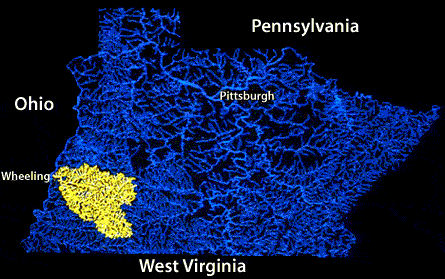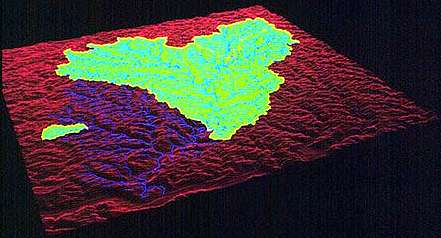
Hydrosphere:
Studying the Hydrosphere
The watershed
approach to monitoring water quality is a systematic approach. The
quality of water flowing at a particular site is compared to the quality
of water flowing at sites upstream. The watershed, sometimes referred
to as the catchment area or
drainage
basin, is defined as an area of land where all surface runoff from
rain and snow eventually enters the same system of ground water and flows
to common streams. The system of streams in a watershed forms an intricately
linked drainage network. The major channels of this drainage network are
referred to as "trunk streams".
The finer channels that feed the trunk streams are called "tributaries".

Watersheds can be used to define large drainage areas or small ones. For example, the Wheeling Creek Watershed (shown above) is the basin containing all of the tributaries of Wheeling Creek, which flows into the Ohio River near Wheeling, WV. This is a small watershed in comparison to that of all the tributaries of the Mississippi River, which eventually drains into the Gulf of Mexico. Image courtesy of Dr. Trevor Harris.
Streams within a watershed are ranked by relative size and structure. The rank of a stream is referred to as stream order. Stream order is a very important part of the watershed approach to examining water quality. It enables one to examine the quality of streamwater at a particular site with that of a stream of similar size and structure at another point in the watershed. The image below is a computer-generated topographic map of Wheeling Creek Watershed. It displays the difference in size between a third-order watershed and a fifth-order watershed. A third-order watershed is a catchment area in which all the water drains into a third-order stream. A fifth-order watershed is a catchment area in which all the water drains into a fifth-order stream.

Image: Computer-generated topographic map of Wheeling Creek Watershed. Surrounding areas are shown in red, a third-order catchment is shown in green on the left, a fifth-order catchment is shown in green on the right, and the remainder of Wheeling Creek Watershed is shown in purple. Image courtesy of Dr. Trevor Harris.
As water flows through a watershed, the size of the stream channel increases and the influence of the surrounding forest on the biotic (living) community in the stream decreases. One model for changes in biological communities that might take place as water travels from small headwater streams to larger rivers is referred to as the River Continuum Concept. This model was first proposed by Vannote and others in 1980. It can be used to determine the biological community one could expect to find in a section of stream based on stream order, alone. This is important to the watershed approach in that one could compare the expected biological community composition to that which is actually observed. Differences between expected and observed biological communities may be due to pollution in the stream.
Overview
..|.. Importance
of Clean Freshwater ..|..
Studying the
Hydrosphere Home
..|..
Teacher Pages
..|..
Modules
& Activities
Glossary .|.
Related Links
.|..
References
..|..
PBL Model
.|
HTML code by Chris Kreger
Maintained by ETE Team
Last updated November 10, 2004
Some images © 2004 www.clipart.com
Privacy Statement and Copyright © 1997-2004 by Wheeling Jesuit University/NASA-supported Classroom of the Future. All rights reserved.
Center for Educational Technologies, Circuit Board/Apple graphic logo, and COTF Classroom of the Future logo are registered trademarks of Wheeling Jesuit University.
